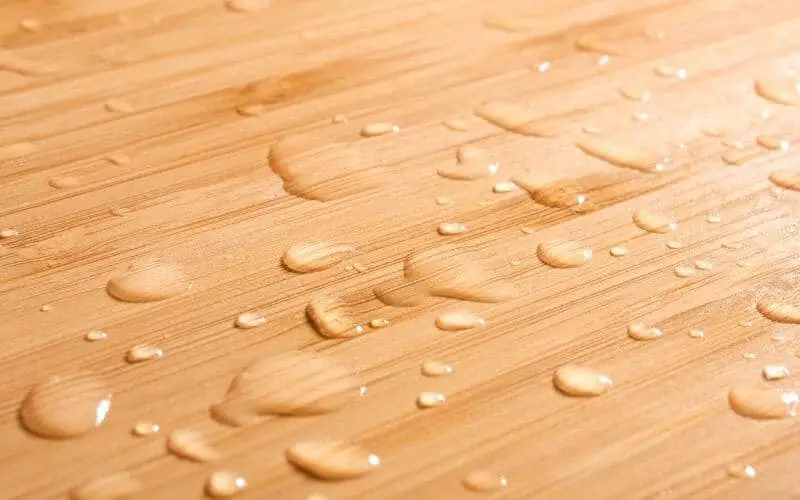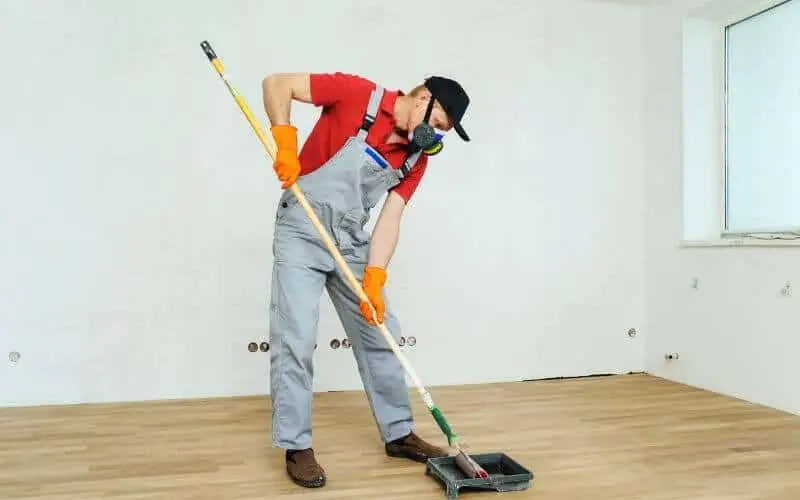What exactly does water popping wood floors actually mean? Water-popping is a term given to the process of applying water to your wood floor after sanding it and before applying a stain.
Water-popping helps to achieve an even and better stain appearance. Water popping helps to condition your wood floor and impacts the level of stain penetration.
As helpful as this may seem, there are some risks associated with water-popping, and if not properly carried, it could lead to the damage of your entire floor.
Read: How to fix uneven stain on hardwood floor
How To Water Pop Wood Floor
Table of Contents
The first step in the water-popping process is ensuring that you use purified water; using tap water is not recommended because it can sometimes contain chemicals that can harm the wood. If you want your wood to dry quickly, you can use a mix of 1:1 water/denatured alcohol.
Also, ensure to test the floor’s moisture content using a moisture meter before you start the water-popping process; this is so that you can tell when the floor is fully dry.
There are a couple of different ways to water pop your wood floor. You can use a water jug and a T-bar to pour and spread the water around the floor or a bucket of water and clean rags to wipe water onto the floor.
Sprayers can also be used to mist the floor with water as well. But this article is going to be discussing the sprayer method.
Use a sprayer to pour a 2-inch line of water along the wood floor, then use a T-bar to even out the water. This is a super important step and should be done very evenly, or you may have to start the process all over again.
Repeat the process working in small sections until you apply water to the entire floor. And once the entire floor has been covered, allow it to dry for at least four hours.
Please note that the exact time it will take your floor to dry will depend on environmental conditions such as temperature, humidity, and air circulation.
Once the floor is dry, it should take on a gritty texture rather than be completely smooth; this indicates that the floor is ready to be stained.
Before you proceed with the next step, ensure to check the floor for inconsistencies; if you find an area that is more smooth or rougher than the rest, it means that the water was not evenly applied.
So you will have to re-sand the floor and start the water-popping process all over again, to prevent the stain from appearing splotchy after application.
But if after double-checking the newly water popped floor and you find no missed spots, you can begin staining.
Read: How to stain laminate floors
Benefits Of Water Popping Wood Floors
Even Stain Application
There are different ways to sand a hardwood floor, different tools like the belt sander, edger, buffer and trio are all used across the floor with different paper grits.
However, during each sanding stage, the floor’s grain closes and tightens more, and this usually happens unevenly due to the nature and technique of the sanding machines used. You may find that the center of the floor have more open grain compared to the edges because two different sanding machines were used.
But when the floor is water popped evenly, it evens out all of the hardwood floors grain, and they all become equal.
So when the stain is applied, you do not have to worry about any area accepting the stain differently or the floor becoming blotchy.
It Gives The Stain A Darker And Richer Color
Dark stain colors for wood floors is a very dramatic and classy look when done correctly; this is why many people desire it. But to achieve a dark and evenly stained floor, your hardwood floor needs to be water-pop.
This is so that you do not end up with lighter results than what you were expecting because when the floor is smoothened out, and the grain is closed after sanding, the stain won’t have enough wood fibres to soak into, and most of the stain is wiped off leaving behind the very little stain that has penetrated the wood.
This causes the floor to turn out lighter than what you saw in your stain sample, but when the floor is water popped, and the grain is fully opened, it will create the perfect surface for the stain to absorb into the wood so you can achieve that deep, dark rich color that you desired.
To ensure that the shade you have on your stain sample isn’t different from what you end up with, always make sure to ask for a water popped sample before choosing a color.
Read: How to lighten stained wood
Eliminates Sanding Marks
Water popping also helps to remove missed sanding marks that are bound to be left behind on the floor after sanding, especially when using an edger.
If the floor is not water popped, the stain will leave a noticeable darker shade in the missed sanding marks.
When this occurs, no amount of water popping would be able to savage the effect that is usually very prominent.
When a wood floor is water popped, the grain is raised, and any tiny cross-grain marks are minimized and blended into the woods fibres.
Read: How to get rid of wood stain smell
To Achieve A Deep And Stronger Finish.
The water popping process raises the wood fibres; this gives the hardwood floor more surface for the finish to stick to and absorb into.
When the first coat of finish on the floor, it soaks into the grain and flows out across the surface and due to the fibrous nature of the popped grain, the first coat has much more surface to penetrate into.
This enables you to achieve a stronger coating than you would with just coating over a smooth, closed grain hardwood floor.
Read: Can engineered floor be refinished
Factors To Consider About Water Popping
Although water popping has lots of benefits for your floor, there are certain factors you need to put into consideration to determine if the extra effort is worth it:
Type Of Wood
How your wood species reacts to stain depends on their grain structure and the consistency of grain density/direction throughout each piece.
Some wood species like pine, maple or hickory can look blotchy when stained without being water popped; so, to achieve an even staining result, your wood needs to be water popped.
You need to know how each particular wood species will react to being water popped before doing so.
Read: How to stain maple floors
Desired Floor Color/Contrast
When a wood floor is water popped, it increases the saturation of the floor stain to create a darker but even color on each board; and less contrast between the hard and soft grain areas.
So if you want the floor to reflect the natural stain color or have more hard/soft grain contrast, you do not need water popping.
How Long The Floor Dries For
After water popping your wood, you need to allow the floor to dry thoroughly before applying the stain; it is best to allow the floor to dry overnight with added airflow.
You should also use a moisture meter to test if the floor is dry before moving on to stain. So before you begin the process of water popping, keep in mind that the process will increase the overall job time.
Read: How long does it take polyurethane to cure
Conclusion
Water popping wood floors is beneficial and will enable the staining process to turn out evenly without any blotchy areas. However, there are factors that you should put into consideration to determine if water popping is right for your hardwood floor before carrying out the process.

